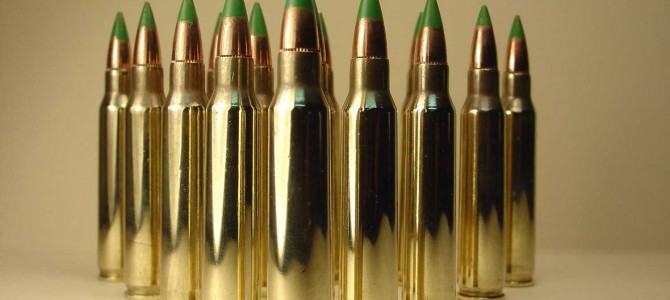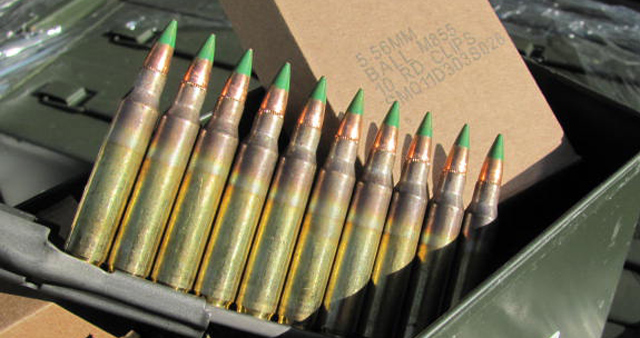
Earlier this year, the federal Bureau of Alcohol, Tobacco, and Firearms (ATF) unexpectedly announced that it planned to characterize all M855/SS109 ammunition (5.56x45mm) as armor-piercing and ban its manufacture. The ATF claims that its authority comes from a 1986 federal statute that defines armor-piercing ammunition and gives ATF the authority to ban it.
Unfortunately, the ATF’s claim is nonsense. It has no such authority to ban a rifle round that is economical, popular (especially among those who own AR-15s), and far less lethal than many other types of common rifle ammunition on the market. The ATF does not have that authority now and did not have it back in 1986 when the law was first passed. At its core, this is a naked and lawless power grab meant to effectuate gun control that the administration is unable to obtain via the ballot box or the legislature.
Here is the precise statutory definition of “armor-piercing ammunition,” which can be found in 18 U.S.C §921(a)(17):
(17)
(A) The term ‘ammunition’ means ammunition or cartridge cases, primers, bullets, or propellent powder designed for use in any firearm.
(B) The term ‘armor piercing ammunition’ means—
(i) a projectile or projectile core which may be used in a handgun and which is constructed entirely (excluding the presence of traces of other substances) from one or a combination of tungsten alloys, steel, iron, brass, bronze, beryllium copper, or depleted uranium; or
(ii) a full jacketed projectile larger than .22 caliber designed and intended for use in a handgun and whose jacket has a weight of more than 25 percent of the total weight of the projectile.
(C) The term ‘armor piercing ammunition’ does not include shotgun shot required by Federal or State environmental or game regulations for hunting purposes, a frangible projectile designed for target shooting, a projectile which the Attorney General finds is primarily intended to be used for sporting purposes, or any other projectile or projectile core which the Attorney General finds is intended to be used for industrial purposes, including a charge used in an oil and gas well perforating device.
This definition is really, really important when comes to the issue of whether M855 ammunition is “armor-piercing” or not. Interestingly enough, the definition does not require that so-called armor-piercing ammunition actually be capable of piercing armor.
The definition includes two main parts, at least one of which must be satisfied before ammunition can be classified as being “armor-piercing” and therefore subject to prohibition. Furthermore, each of the two parts contains multiple conditions, all of which must be satisfied. You cannot mix and match requirements from the two distinct definitions (the supreme importance of this point will become clear later). We’ll look at each of the two major definitions separately.
The first definition, from (B)(i) above, requires all of the following: a projectile (or bullet) must be 1) usable in a handgun, and 2) constructed entirely from “one or a combination of tungsten alloys, steel, iron, beryllium copper, or depleted uranium.”
Is M855 ammunition usable in a handgun? Yes. Although it’s primarily a rifle round, some handgun manufacturers built handgun platforms around it. Is the M855 projectile constructed entirely from one or a combination of those materials listed in the statute? No. It’s made from a combination of steel and lead, and lead is not one of the materials listed in the statutory definition of “armor-piercing ammunition.”
What does this mean? It means that the first statutory definition for “armor-piercing ammunition” fails to apply to M855 ammunition, since both conditions were not satisfied.
Majority of House members sign letter blasting Obama bullet ban proposal – http://t.co/Eky8ycq95W #NRA #2A #M855 (via @foxnews)
NRA News (@nranews) March 5, 2015
But even if we grant for the sake of argument that those two conditions in the first definition appear to have been met, there’s one more problem for the ATF: the federal statute never actually defines “projectile.” Why is this important? It’s important because most ammunition is jacketed with gilding metal, usually a combination of copper and zinc. Plain copper and zinc are not included in the statutory list of restricted materials.
In its justification for banning M855, ATF states that while previous M855 cartridges had been exempt (a cartridge is the completed combination of a primer, propellant, projectile, and casing), the pre-cartridge projectile had not been exempted by ATF. If “projectile” is the material that’s inserted into a cartridge, then the the statutory definition is once again not met, because that projectile contains copper alloy in the jacket, and neither plain copper nor zinc appears in the law’s list of restricted materials. And why is it sensible to include the copper jacket in the definition of projectile? Because the jacket is projected from the gun and the shell casing when the gun is fired. It is part of the projectile.
Lest you think this represents an absurd reading of the statute, keep in mind that the law’s authors were aware of ammunition construction and the importance of a round’s jacket. How do we know? Because the second definition in the law specifically references projectile construction. It uses the term “full jacketed projectile” and then sets down clear guidelines about jacket size (full) and weight (less than 25 percent of the full weight of the projectile). The grammar of that phrase alone — full jacketed projectile — implies that a projectile can have a full jacket, partial jacket, or no jacket. The jacket and projectile are one. Furthermore, the weight guideline also mandates that the jacket and bullet be treated as a single unit for weight measurement purposes. But no matter how you slice it, the language suggests that the jacket is absolutely part of the projectile.
Overall, it is abundantly clear that the first part of the statutory definition of “armor-piercing ammunition” does not include M855 ammunition. But what about the second definition in the statute? Let’s take a look.

The second definition, from (B)(ii) above, requires all of the following: 1) a fully jacketed projectile, and 2) larger than .22 caliber, and 3) designed for use in a handgun, and 4) intended for use in a handgun, and 5) a jacket that weighs at least 25 percent of the total weight of the projectile. Let’s go item by item and see if each condition is satisfied.
Is the 5.56x45mm M855/SS109 projectile fully jacketed? While there seems to be a fair amount of debate about this, we’ll go with yes, since the steel tip of the projectile is generally covered by the copper jacket. Is it larger than .22 caliber? Again, even though there’s debate about this (.22 caliber is never defined, and the M855 round is actually smaller than other variants of .22 ammunition on the market; the lack of a third decimal point is also problematic), we’ll go with yes again. So far the first two conditions of this particular definition appear to have been satisfied. But here comes the most important: was the M855 round designed for use in a handgun?
The answer is no. Absolutely not. Not even close.
On no planet can it be possibly argued that it was developed for handgun use. How do we know? Because the 5.56x45mm round was designed and manufactured long before any handguns that could fire it even existed. It was developed in the late 1950s and 1960s for use in rifles and was finally standardized by the United States for use in 1963 for the ArmaLite M16. The M855 round, a variant of the 5.56x45mm, is the U.S. version of the Belgian SS109 round, which was developed by the Belgian company Fabrique Nationale, or FN, in the 1970’s. The FN SS109 was also designed and exclusively intended for use in a rifle. The United States first put the M855 to use in the M16A2 platform in the early 1980s. Handgun platforms capable of firing the round were not developed until long after the M855 round was designed, developed, manufactured, and sold. The ATF admitted as much when it wrote that handguns capable of firing the M855/SS109 “were not commercially available when the armor piercing ammunition exemption was granted in 1986.”
You read that correctly: the ATF plainly admits that the round could not possibly have been designed for a handgun, right before the agency wrongfully assumes the authority to mix and match conditions from the two different definitions in the statute.
This sleight of hand actually forms the entire foundation of the ATF’s power grab: since one condition in one part of one definition states that ammunition might be “armor-piercing” if it can be used in a handgun, the ATF claims it has the power to regulate and ban that ammunition. A plain reading of the statute clearly shows that ATF’s interpretation is nonsense.
We know that M855 fails to meet part three of the second definition of armor-piercing ammunition. But what about part four? Was this round intended by its manufacturer to be used as a handgun round? No, it wasn’t, for the same reasons it wasn’t designed to be a handgun round. And what about part five? Is the bullet jacket’s weight equal to or greater than 25 percent of the weight of the bullet itself? Yes. Although several posts floating around state that the jacket on a 62gr green tip bullet weighs only 10.8gr, which is less than 25 percent of the full 62gr weight, it appears that the actual weight is much closer to 20gr, or more than 30 percent of the total weight of the projectile.
However, because parts three (designed to be used in a handgun) and four (intended to be used in a handgun) of the definition do not apply to the M855 round, the fact that parts one, two, and five are satisfied is irrelevant. The statute clearly and deliberately uses the word “and,” which means each and every condition must be satisfied.
The first definition in the statute fails to apply to the M855 round, and the second definition in the statute fails as well. Therefore, it must mean that the ATF does not have the statutory authority to characterize the M855 round as armor-piercing and certainly does not have the authority to ban its manufacture. Because the M855 round is not composed entirely of the materials specified in the statute, it is irrelevant that it can be used in a handgun. And because the round was never designed or intended to be used in a handgun, it is irrelevant that it is fully jacketed, is larger than .22 caliber, and has a jacket weight that exceeds 25 percent of the projectile’s total weight.
Even though the ATF currently claims that the round was always covered under the 1986 law defining armor-piercing ammunition and that the agency only temporarily exempted it from regulation and prohibition, that is also false. ATF never had that authority. It was the clear language of the statute, not the ATF’s good graces, that excluded M885 ammo from its definition.
The ATF didn’t have the authority then, and the Obama administration doesn’t have the authority now, to ban this ammunition. It is a lawless power grab that should be treated as such by each court that is given an opportunity to review it.
The nonsense of the legal theory of the ATF — that a round that can be used in a handgun counts as “armor-piercing” and is therefore subject to prohibition — is especially problematic when you note that it can be extended to nearly ever single type of firearm ammunition on the market. Know what other types of popular ammunition can be fired in a handgun? 9mm, .40 S&W, .45 ACP. The list goes on and on. Even shotgun rounds could theoretically be banned since there are handgun platforms capable of firing buckshot, birdshot, or slugs. Furthermore, all the ATF would need to do to justify a ban on all rifle ammo would be to develop a handgun, any handgun, capable of firing each caliber of rifle ammunition. There is no limiting principle whatsoever to the tortured legal logic of the ATF’s rule on M855 ammunition.
Frederick Douglass, who escaped slavery and later helped lead the abolitionist movement, once remarked, “A man’s rights rest in three boxes. The ballot box, jury box, and the cartridge box.” Unfortunately, Barack Obama’s administration apparently wants to ban the latter without ever putting it to the test at the former.









